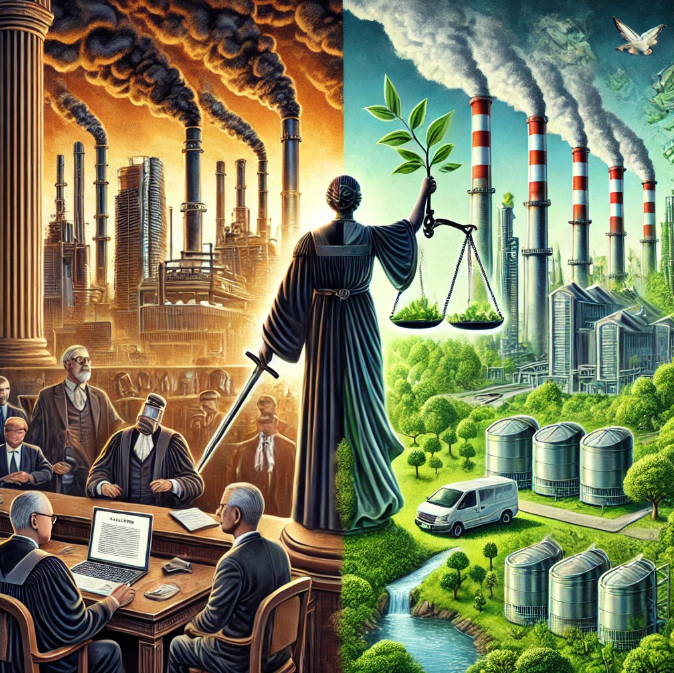
The Air (Prevention and
Control of Pollution) Act, 1981: A Comprehensive Guide
Introduction
Air pollution has emerged as a
severe environmental challenge in India, contributing to health problems,
climate change, and ecological damage. With rising industrialization,
urbanization, and vehicular emissions, India has been struggling with deteriorating
air quality.
To address this crisis, the Air
(Prevention and Control of Pollution) Act, 1981 was enacted as a legal
framework to regulate and control air pollution. This Act empowers regulatory
authorities to take necessary steps to reduce pollutants in the atmosphere, set
emission standards, and enforce penalties on violators.
This article provides a detailed
examination of the Air Act, including its provisions, implementation
mechanisms, penalties, and impact on pollution control in India.
Understanding the Air
(Prevention and Control of Pollution) Act, 1981
Objective and Purpose of the
Act
The Air Act, 1981 was
introduced to:
- Prevent, control, and reduce air pollution across
India.
- Establish regulatory authorities to oversee air
quality management.
- Set permissible limits for industrial and vehicular
emissions.
- Promote awareness and public participation in
pollution control efforts.
Key Definitions Under the Act
The Act defines key terms such
as:
- Air Pollutant – Any solid, liquid, or
gaseous substance present in the atmosphere in a concentration that may be
harmful.
- Air Pollution – The presence of air
pollutants beyond permissible limits, causing health or environmental
hazards.
- Pollution Control Board – Regulatory bodies
responsible for monitoring and enforcing pollution norms.
How the Act Differs from Other
Environmental Laws
While the Water (Prevention
and Control of Pollution) Act, 1974 primarily regulates water pollution,
the Air Act, 1981 focuses specifically on air quality. Additionally, the
Environment Protection Act, 1986 provides an overarching legal
framework, but the Air Act remains the primary legislation for air pollution
control.
Key Provisions of the Air Act,
1981
The Air Act introduced the
establishment of:
- Central Pollution Control Board (CPCB) –
Responsible for setting national standards and guidelines.
- State Pollution Control Boards (SPCBs) –
Implement and monitor pollution control measures at the state level.
The Act prohibits the release of
air pollutants beyond prescribed limits and mandates industries, power
plants, and vehicles to comply with air quality regulations.
It also gives government
authorities the power to shut down or restrict the operations of industries
that violate pollution norms.
Causes and Sources of Air
Pollution Addressed by the Act
The Air Act targets major
pollution sources, including:
- Industrial Emissions – Factories release
harmful pollutants such as sulfur dioxide (SO₂), nitrogen oxides (NOₓ),
and particulate matter (PM).
- Vehicular Pollution – Motor vehicles
contribute significantly to air pollution through carbon monoxide (CO) and
unburned hydrocarbons.
- Construction and Dust Pollution – Rapid
urbanization has led to increased dust pollution.
- Agricultural Practices – Stubble burning in
states like Punjab and Haryana worsens air quality.
- Household Emissions – Use of biomass for
cooking contributes to indoor and outdoor air pollution.
Penalties and Legal
Consequences for Violating the Air Act
Violations of the Air Act result
in:
- Fines of up to ₹10,000 for first-time
offenses.
- Imprisonment up to six years for repeated
violations.
- Closure of industries by the Pollution Control
Boards for non-compliance.
Case Studies of Major
Violations
- In 2018, the Supreme Court imposed fines on the Delhi and Haryana governments for failing to control stubble burning.
- Several thermal power plants have been penalized
for exceeding permissible emission levels.
Role of the Judiciary in
Enforcing the Air Act
Indian courts have played a
critical role in enforcing the Air Act through landmark judgments:
- MC Mehta v. Union of India (1998) – The Supreme
Court ordered the conversion of Delhi’s public transport system to CNG to curb
vehicular pollution.
- Vellore Citizens Welfare Forum v. Union of India
(1996) – Addressed industrial pollution in Tamil Nadu.
Challenges and Future of Air
Pollution Control in India
Despite its legal framework, the Air
Act faces implementation challenges such as:
- Lack of proper monitoring and enforcement.
- Industrial resistance to stricter regulations.
- Political and economic pressures are delaying policy
implementation.
Future Prospects
- Strengthening air pollution laws through
amendments.
- Adoption of green technology in industries and
transport.
- Increased public awareness and participation in
pollution control efforts.
Final Thoughts
The Air (Prevention and Control
of Pollution) Act, 1981 is a crucial legal instrument in India's fight against
air pollution. However, stricter enforcement, advanced technology, and
community participation are needed to achieve cleaner air and a healthier
environment.
